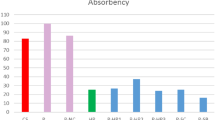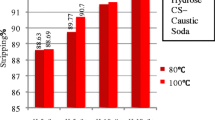Abstract
Color stripping is a primary technique for recycling fabric. In view of cost, time and energy effectiveness in present research, microwave assisted sequential stripping of cotton with fixed Reactive Blue Black 5 and Turquoise CLB was developed as an alternate method to conventional stripping. After microwave assisted alkali → oxidation → reduction treatment, 98% and 97% stripping efficiency was obtained in 120 s, for reactive blue black 5 and reactive turquoise CLB respectively. Similarly, 97% and 94% stripping efficiency was calculated by sequential acid → oxidation → reduction in 120 s, while similar results were obtained by conventional methods in 60 min. However, a minor discrepancy in terms of weight loss and tearing strength was also observed in the sequential microwave assisted methods in comparison to conventional methods. Assessment of redyeability of stripped cotton fabric against all in-vogue methods proved microwave assisted method to be a better commercial option than any other one for stripped fabric quality, time, energy and cost effectiveness.
Graphical abstract








Similar content being viewed by others
Data availability
Not applicable.
References
Abhyankar PN, Beck KR, Ladisch CM, Rowland SP (1985) A new and effective method for removing DMDHEU crosslinks from cotton 1. Text Res J 55:444–448. https://doi.org/10.1177/004051758505500708
Agrawal P, Nierstrasz V, Warmoeskerken M (2006) The performance of cutinase and pectinase in cotton bioscouring. A novel and fast low temperature bioscouring process. In: Proceedings ot the 4th international conference on textile biotechnology. Seoul, Korea, pp 103
Arooj F, Ahmad N, Chaudhry MN (2015) A pilot-scale application of ozone to bleach raw cotton fabric using various additives. Ozone Sci Eng 37:203–215. https://doi.org/10.1080/01919512.2014.956861
Arooj F, Ahmad N, Shaikh IA, Chaudhry MN (2014) Application of ozone in cotton bleaching with multiple reuse of a water bath. Text Res J 84:527–538. https://doi.org/10.1177/0040517513499429
Arooj F, Ahmed N, Shaikh IA (2020) Application of ozone in stripping of cotton fabric dyed with reactive dyes. Ozone Sci Eng 42:319–330. https://doi.org/10.1080/01919512.2019.1667750
Aspland JR (1997) Textile dyeing and coloration. Am Assoc Text Chem Color, North Carolina
Bigambo P, Carr CM, Sumner M, Rigout M (2020) The effect of the acid/dithionite/peroxide treatments on reactively dyed cotton and indigo dyed denim and the implications for waste cellulosic recycling. J Text Inst 111:785–794. https://doi.org/10.1080/00405000.2019.1662874
Bigambo P, Liu H, Broadbent PJ, Carr CM, Rigout M (2018) Surface chemical and colorimetric analysis of reactively dyed cellulosic fabric. The effect of ISO 105 CO9 laundering and the implications for waste cellulosic recycling. Dyes Pigm 148:91–98. https://doi.org/10.1016/j.dyepig.2017.08.062
Broadbent AD (2001) Basic principles of textile coloration. J Soc Dye Colour, Bradford, UK
Butts KR (2004) Applied technology-keys to reliable digital color communication-Identifying and controlling the sources of variation in the measurement process are the keys to improving digital data reliability. Am Assoc Text Chem Color 4:15–19
Chatha SAS, Ali S, Asgher M, Bhatti HN (2011) Investigation of the potential of microbial stripping of dyed cotton fabric using white rot fungi. Text Res J 81:1762–1771. https://doi.org/10.1177/00405175114119
Chatha SAS, Asgher M, Ali S, Hussain AI (2012) Biological color stripping: a novel technology for removal of dye from cellulose fibers. Carbohydr Polym 87:1476–1481. https://doi.org/10.1016/j.carbpol.2011.09.041
Chatha SAS, Asgher M, Iqbal HM, Ali S (2016) A novel enzymatic stripping of CI reactive black B dyed knitted textiles fabric as an environmentally responsible technology. Elect J Bio 12:276–281
Choudhury AKR (2017) Sustainable chemical technologies for textile production. In: Sustainable Fibres and textiles, 1st edn. Woodhead Publishing, New Delhi, pp 267–322. https://doi.org/10.1016/B978-0-08-102041-8.00010-X
Chung C, Lee M, Choe EK (2004) Characterization of cotton fabric scouring by FT-IR ATR spectroscopy. Carbohydr Polym 58:417–420. https://doi.org/10.1016/j.carbpol.2004.08.005
Dockery CR, Stefan AR, Nieuwland AA, Roberson SN, Baguley BM, Hendrix JE, Morgan SL (2009) Automated extraction of direct, reactive, and vat dyes from cellulosic fibers for forensic analysis by capillary electrophoresis. Anal Bioanal Chem 394:2095–2103. https://doi.org/10.1007/s00216-009-2876-8
Eren HA, Gundogan S, Eren S, Kocaman B (2013) Substitution of reduction clearing step by ozone treatment at disperse dyeing of polyester. Ozone Sci Eng 35:196–200. https://doi.org/10.1080/01919512.2013.771551
Eren S, Gümüş B, Eren HA (2016) Colour stripping of reactive-dyed cotton by ozone treatment. Color Tech 132:466–471. https://doi.org/10.1111/cote.12240
He FN, Li X, Zhu MK, Hu JH, Yuan YJ, Li CC, Long JJ (2019) Color stripping of reactive-dyed cotton fabric in a UV/sodium hydrosulfite system with a dipping manner at low temperature. Cellulose 26:4125–4142. https://doi.org/10.1007/s10570-019-02336-w
He JM, Xie CF, Long JJ (2021) Sustainable color stripping of cotton substrate dyed with reactive dyes in a developed UV/K2S2O8 photocatalytic system. J Taiw Inst Chem Eng 121:241–256. https://doi.org/10.1016/j.jtice.2021.04.023
Long JJ, Cui CL, Zhang YQ, Yuan GH (2015) Clean fixation of dye on cotton in supercritical carbon dioxide with a heterogeneous and phase transfer catalytic reaction. Dyes Pigm 115:88–95. https://doi.org/10.1016/j.dyepig.2014.12.018
Long JJ, Liu B, Wang GF, Shi W (2017) Photocatalitic stripping of fixed Reactive Red X-3B dye from cotton with nano-TiO2/UV system. J Clean Prod 165:788–800. https://doi.org/10.1016/j.jclepro.2017.07.149
Määttänen M, Asikainen S, Kamppuri T, Ilen E, Niinimäki K, Tanttu M, Harlin A (2019) Colour management in circular economy: decolourization of cotton waste. Res J Text Apparel 23:1560–6074. https://doi.org/10.1108/RJTA-10-2018-0058
Matsui M, Meyer U, Zollinger H (1988) Dye-fibre bond stabilities of dyeings of bifunctional reactive dyes containing a monochlorotriazine and a ß-hydroxyethylsulphone sulphuric acid ester group. J Soc Dye Colour 104:425–431. https://doi.org/10.1111/j.1478-4408.1988.tb01140.x
Oğulata RT, Balci O (2007) Investigation of the stripping process of the reactive dyes using organic sulphur reducing agents in alkali condition. Fibers Polym 8:25–36
Palme A, Theliander H, Brelid H (2016) Acid hydrolysis of cellulosic fibres: comparison of bleached kraft pulp, dissolving pulps and cotton textile cellulose. Carbohydr Polym 136:1281–1287. https://doi.org/10.1016/j.carbpol.2015.10.015
Pearce CI, Lloyd JR, Guthrie JT (2003) The removal of colour from textile wastewater using whole bacterial cells: a review. Dyes Pigm 58:179–196. https://doi.org/10.1016/S0143-7208(03)00064-0
Perincek S, Bahtiyari MI, Körlü AE, Duran K (2008) Ozone treatment of Angora rabbit fiber. J Clean Prod 16:1900–1906. https://doi.org/10.1016/j.jclepro.2008.01.005
Postle R (1990) Fabric objective measurement technology: present status and future potential. Int J Cloth Sci Tech 2:7–17. https://doi.org/10.1108/eb002962
Powar A, Perwuelz A, Behary N, Hoang LV, Aussenac T, Loghin C, Chen G (2021) Environmental Profile study of ozone decolorization of reactive dyed cotton textiles by utilizing life cycle assessment. Sustainability 13:1225. https://doi.org/10.3390/su13031225
Sadi MS, Nahar N, Shakhawat HM, Sajib SH (2018) Amendment of finished knitted fabric quality by reducing the intensity of defects and improvement techniques. Am J Mater Sci 8:6–14. https://doi.org/10.5923/j.materials.20180801.02
Shinkafi MS, Mohammed IU, Audu AA (2015) The potentials of white-rot fungi to decolorizing azo dyes and organic components of textile effluents. Eur J Biotech Biosci 3:52–57
Tayyaba N, Younas T, Ali S (2021) Chemical color stripping of cellulose fabric dyed with reactive dyes. Int J Sci Innov Res 2:2724–3338
Uddin MG, Islam M (2015) Effects of reductive stripping of reactive dyes on the quality of cotton fabric. Fash Text 2:1–12. https://doi.org/10.1186/s40691-015-0032-y
Acknowledgments
This manuscript is a part of M.Phil. dissertation of Mubashar Alam. The textile and color chemistry laboratory, department of chemistry, University of Agriculture, Faisalabad, Pakistan provided facilities for this research work. Applied chemistry laboratories of the Government College University, Faisalabad and National Textile University, Faisalabad, Pakistan provided facilities for analysis.
Funding
There are no funding sources.
Author information
Authors and Affiliations
Contributions
MA Methodology and all experimental work, Formal analysis, Conceptualization Data curation, original draft preparation SA Supervision, Project development, and management, Funding acquisition, Conceptualization, Laboratory facilities, Resources, Validation, Investigation SN Editing and review of the original draft TZ Data curation AA Drafting and experimental work MAAK Editing and review of manuscript.
Corresponding author
Ethics declarations
Conflict of interest
There are no conflicts to declare.
Ethical approval and consent to participate
Not applicable.
Consent for publication
All authors showed consent to publish the work.
Additional information
Publisher's Note
Springer Nature remains neutral with regard to jurisdictional claims in published maps and institutional affiliations.
Rights and permissions
Springer Nature or its licensor (e.g. a society or other partner) holds exclusive rights to this article under a publishing agreement with the author(s) or other rightsholder(s); author self-archiving of the accepted manuscript version of this article is solely governed by the terms of such publishing agreement and applicable law.
About this article
Cite this article
Alam, M., Ali, S., Noureen, S. et al. Study of microwave-assisted sequential color stripping of cellulosic fabric dyed with reactive blue black 5 and reactive turquoise CLB. Cellulose 30, 5339–5354 (2023). https://doi.org/10.1007/s10570-023-05182-z
Received:
Accepted:
Published:
Issue Date:
DOI: https://doi.org/10.1007/s10570-023-05182-z




